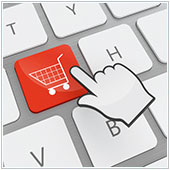
1. Watch what you share
Security experts continually rant about this regarding social media usage, but it is also relevant to e-commerce. Often when you make an online purchase you will be asked to provide some personal information. This might include your shipping and billing address, birthday, or other factors. Many sites often ask for more information than they really need to complete the order?
The reason companies ask for this additional information is so they can get to know you better, and provide more relevant, targeted product recommendations. But some more dubious sites may ask you for this information and later sell it to a third party. When making purchases online, you should be aware of what information is really required – usually indicated by an asterisk – and what isn’t. Only share information that is absolutely necessary.
Beyond that, if you are planning to link a digital wallet to your mobile phone, you should be careful who you share or lend your phone to. These services are set to take off in a big way, and there has already been instances of people with digital wallets being duped by strangers asking to borrow their phones in order to find their wallet. It is a good idea to restrict wallet access and not store any valuable information on your phone’s internal storage. Instead, store it in a password protected cloud storage site.
2. Watch how you connect
As we become more comfortable with using phones, tablets, and laptops for online shopping, we begin to rely on them more and more, and use them in many locations away from the home or office. Convenience and portability mean we can shop from wherever we may be. But, many people may fail to realize that they are connecting to public Wi-Fi when they are on the go. Sure, it is cool to be able to buy your groceries on Amazon from the coffee shop at lunch, but if you have connected to public Wi-Fi, your information is likely wide-open – anyone with the right tools can access it.
Be careful when you shop. Don’t enter any valuable or important information like passwords and credit card numbers while connected to public Wi-Fi. If your mobile device has a data plan, switch to that instead. Or, wait until you are connected to a secure Wi-Fi network.
3. Verify all sites
When you are shopping online you should verify that the site is in fact legitimate. The easiest way to do this is to take a look at your browser’s URL bar, and more specifically the website’s address. You are looking for it to start with “https://”. What this indicates is that the website has been authenticated as being legitimate. Most websites like Amazon, Google, Apple, Facebook, etc. all have https protocols. If you don’t see this in the address, you may be looking at a fake website.
If you are unsure, try entering https:// before the Web address and hitting Enter. You should also take note of this URL when you are checking-out, because if there is no https://, the site may be sending unsecured information. That information could be your credit card number if you’re not careful.
If you are shopping from a new website, take time to look through the extra information like the About Us and Contact pages. Take note of the address and company names, then search for the company on say Wikipedia or Google, taking care to see if the address is the same. Another trick is to search the various social media services like Facebook and Twitter for accounts related to the website.
4. Don’t pay with your bank account
One of the benefits of e-commerce is that it is easy, and the number of users buying stuff online is growing exponentially. Banks are aware of this trend and have launched services that allow you to pay for transactions with your debit card. The problem with this is these cards are directly linked to your bank account, often with higher limits than credit cards. It can be incredibly tough to get money back if something happens, largely because as soon as your account has been debited, the money is gone.
Many people who shop online use a credit card. The main reason for this is because most banks and card issuers offer online shopping protection, which makes it easier to get money back should anything undesired happen. The best solution could be to sign up for a credit card that is only used for online purchases, and even linked to a separate bank account. This could minimize your losses should something happen. A debit card for an account that has a limited amount of funds in it at any one time can also be a way to protect your main money pot.
5. Don’t link accounts
For convenience, many online retailers like Amazon, Apple, etc. offer to store your credit card number. It is highly recommended that you don’t allow these sites to store your credit card numbers, especially if you use the same account name or email address as other accounts.
If you get hacked, and the hacker finds that you have say an Amazon account with the same username and password, they will likely go on a shopping spree, which could cost you time and money.
Taking precautions when shopping online is a good idea, and could help mitigate the risk of having your identity or money stolen. If you are looking for more information on how to be safe online, or how to ensure that your company’s online store is secure, please contact us today.

